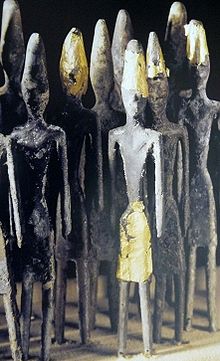A favissa is a cultic storage place, usually a pit or an underground cellar, for sacred utensils and votive objects no longer in use. Favissae were located within the sacred temple precincts of the various ancient Mediterranean civilizations. Archaeologists have found such pits in Ancient Egypt, the Roman world and in the Phoenician and Punic world.[1][2]

Etymology
editThe term is derived from the Etruscan or related to the Latin fovea "pit".[3]
During the time of ancient Rome, the term favissa referred to a cylindrical underground storage space, specifically designed to house votive objects. These repositories were typically located outside the main sanctuary but within the sacred grounds known as temenos. The Roman favissa served a similar purpose as the Greek treasury, functioning as a dedicated space for storing valuable offerings and dedicatory items.[4]
Roman favissae
editSimilar to other ancient religions, the Romans had a tradition of offering relatively inexpensive objects made of materials like bronze, lead, tin, or common clay as votive offerings to the temple deities. Over time, the quantity of these votive objects became excessive, necessitating their removal. However, it was crucial for priests to ensure these offerings remained within consecrated ground and were not profaned. To address this, temple priests took charge of removing the objects; they deliberately broke intact items before burying them within the temple grounds. Care was taken to choose locations which were not easily accessible, thus minimizing the risk of profanation.[4][5]
An example of such a structure is found in the Favissae Capitolinae, designed to house all the votive objects from the Temple of Jupiter Optimus Maximus located on Rome's Capitoline Hill. The prevalence of "favissae" is particularly notable in Magna Graecia, where they were commonly found in significant places of worship. One notable example is the favissa discovered on the Mannella hill in Locri Epizefiri in Reggio Calabria. Although devoid of its contents, this favissa can be dated back to the fifth century BC. As time passed, the use of favissae gradually diminished, to the extent that their significance had been completely forgotten by the imperial era.[4][5]
See also
edit- Bothros – An artificial depression in the ground, used in ancient times for washing and libations.
References
edit- ^ Lacovara 2016, p. 415.
- ^ Lipinski 2003, p. 300–301.
- ^ Walde & Hofmann 1938, p. 467.
- ^ a b c Daremberg & Saglio 1873, p. 1024.
- ^ a b "FAVISSA in "Enciclopedia Italiana"". www.treccani.it (in Italian). Retrieved 2023-07-16.
Sources
edit- Daremberg, Charles Victor; Saglio, Edmond (1873). Dictionnaire des antiquités grecques et romaines, d'après les textes et les monuments (in French). Vol. 2 part 2. University of Ottawa. Paris : Hachette. p. 1024.
- Lacovara, Peter (2016). The World of Ancient Egypt: A Daily Life Encyclopedia [2 volumes]: A Daily Life Encyclopedia. ABC-CLIO. ISBN 978-1-61069-230-4.
- Lipinski, Edouard (2003), "Phoenician Cult Expressions in the Persian Period", Symbiosis, Symbolism, and the Power of the Past, Penn State University Press, pp. 297–308, doi:10.1515/9781575065458-022, ISBN 978-1-57506-545-8, S2CID 239182184, retrieved 2023-07-16
- Walde, Alois; Hofmann, Johann Baptist (1938). Lateinisches etymologisches Wörterbuch (in German). Heidelberg: Carl Winter. p. 467.